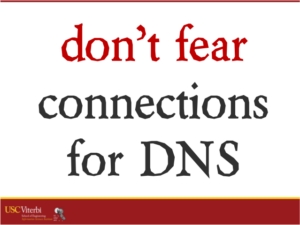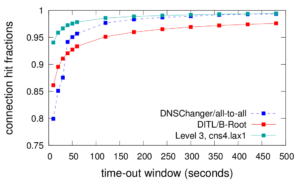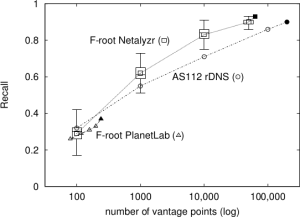John Heidemann gave the talk “T-DNS: Connection-Oriented DNS to Improve Privacy and Security” given at the Spring DNS-OARC meeting in Warsaw, Poland on May 10, 2014. Slides are available at http://www.isi.edu/~johnh/PAPERS/Heidemann14c.html.

From the abstract:
This talk will discuss connection-oriented DNS to improve DNS security and privacy. DNS is the canonical example of a connectionless, single packet, request/response protocol, with UDP as its dominant transport. Yet DNS today is challenged by eavesdropping that compromises privacy, source-address spoofing that results in denial-of-service (DoS) attacks on the server and third parties, injection attacks that exploit fragmentation, and size limitations that constrain policy and operational choices. We propose t-DNS to address these problems: it uses TCP to smoothly support large payloads and mitigate spoofing and amplification for DoS. T-DNS uses transport-layer security (TLS) to provide privacy from users to their DNS resolvers and optionally to authoritative servers.
Traditional wisdom is that connection setup will balloon latency for clients and overwhelm servers. We provide data to show that these assumptions are overblown–our model of end-to-end latency shows TLS to the recursive resolver is only about 5-24% slower, with UDP to the authoritative server. End-to-end latency is 19-33% slower with TLS to recursive and TCP to authoritative. Experiments behind these models show that after connection establishment, TCP and TLS latency is equivalent to UDP. Using diverse trace data we show that frequent connection reuse is possible (60-95% for stub and recursive resolvers, although half that for authoritative servers). With conservative timeouts (20 s at authoritative servers and 60 s elsewhere) we show that : a large recursive resolver may have 25k active connections consuming about 9 GB of RAM. These results depend on specific design and implementation decisions–query pipelining, out-of-order responses, TLS connection resumption, and plausible timeouts.
We hope to solicit feedback from the OARC community about this work to understand design and operational concerns if T-DNS deployment was widespread. The work in the talk is by Liang Zhu, Zi Hu, and John Heidemann (all of USC/ISI), Duane Wessels and Allison Mankin (both of Verisign), and Nikita Somaiya (USC/ISI).
A technical report describing the work is at http://www.isi.edu/ johnh/PAPERS/Zhu14a.pdf and the protocol changes are described ashttp://datatracker.ietf.org/doc/draft-hzhwm-start-tls-for-dns/.


![Visualization of low-rate periodicity, before and after installation of a keylogger. [Bartlett11a, figure 3]](http://ant.isi.edu/blog/wp-content/uploads/2011/04/Bartlett11a_icon-227x300.png)